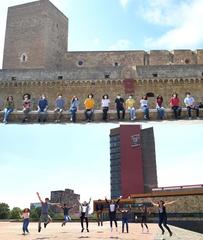URL: https://www.desy.de/news/news_search/index_eng.html
Breadcrumb Navigation
DESY News: Beam them up: high school students turn into researchers
News
News from the DESY research centre
Beam them up: high school students turn into researchers
Two teams of high-school students from the Liceo Scientifico Statale “A. Scacchi” (Bari, Italy) and from the Esculea Nacional Preparatoria “Plantel 2” (Mexico City, Mexico) have won the highly competitive CERN Beamline for Schools competition. The prize is a trip to the DESY research centre in Hamburg, Germany, in autumn 2021, to carry out their proposed experiments with the support of scientists from CERN and DESY.

Group photo of the young researchers: Team Teomiztli (top) from Escuela Nacional Preparatoria 'Plantel 2' (Mexico City, Mexico); and Team EXTRA (bottom) from Liceo Scientifico Statale 'A. Scacchi' (Bari, Italy).
“DESY is very pleased to welcome the Beamline for Schools competition,” says Ties Behnke, DESY’s Director in charge of Particle Physics. “The initiative clearly shows how attractive fundamental research can be to young people. I am very much looking forward to welcoming the winning teams to DESY this autumn, and to observe the experiments take shape.”
Since the competition was launched in 2014, more than 12 000 students from 91 countries have participated. This year, despite the difficulties faced by schools during the COVID-19 pandemic, a record number of 289 teams representing 57 countries submitted a proposal. From the applicants, 26 teams from 22 countries were shortlisted, eight teams from eight countries were selected for a Special Mention, and one team, representing India and Sweden, has been awarded for the most creative video proposal. “Some of the winners of the first editions of BL4S have come back to CERN as members of the experimental collaborations after their studies,” says Margherita Boselli, BL4S project manager. “We hope that we can continue contributing to training the next generation of scientists.”
“I am impressed by the number of participants this year,” says Joachim Mnich, Director of Research and Computing at CERN. “The evolution of the number of participants over the past editions clearly shows that the competition is getting more and more attractive every year.”
The experiments proposed by the winners of the eighth edition show the deep understanding that high-school students can have of modern particle physics when given the opportunity. The Italian team “EXTRA” wants to investigate the transition radiation effect, where X-ray photons are produced when a beam of high-energy electrons crosses the interface between materials with different optical properties. To study this phenomenon, the students will need to find a smart way to discriminate the signals produced by the particles in the beam from those produced by the X-ray photons.
“Thanks to BL4S, we are involved in a real research experiment that taught us the value of everyone’s contribution to a common project and gave us a purpose during the pandemic,” state Domenico Soriano and Vittorio Zupo from the EXTRA team in their proposal. “We are grateful and honoured for this opportunity.”
The experiment proposed by the Mexican team “Teomiztli” focuses on Cherenkov radiation: the production of electromagnetic radiation when high-energy particles travel through certain materials. The goal of the Mexican students is to compare the production of Cherenkov radiation in different materials and contribute to applying this phenomenon in the development of particle detectors.
“Winning the first prize is a great achievement because it will help us promote science in Mexico and help younger people get interested in particle physics and science in general,” says Ilse Buendía from the Teomiztli team.
Beamline for Schools is an Education and Outreach project funded by the CERN & Society Foundation and supported by individual donors, foundations, and companies. The eighth edition is partly supported by the Wilhelm and Else Heraeus Foundation, with additional contributions from the Arconic Foundation, the Amgen Foundation, and the Ernest Solvay Fund, managed by the King Baudouin Foundation.
“What makes BL4S special among student competitions is that the students carry out their own research projects at a research institute such as CERN or DESY. This undoubtedly leads to greater motivation towards scientific careers and a sustained interest in physics and, therefore, the initiative perfectly fits our goals as a foundation,” says Stefan Jorda, Managing Director of the Wilhelm und Else Heraeus Foundation.
Further information:
- BL4S website: https://beamlineforschools.cern/
- 2021 edition: https://beamlineforschools.cern/editions/2021-edition
- Shortlisted and special mention teams 2021: https://beamlineforschools.cern/results_2021
- Previous winners: https://beamlineforschools.cern/bl4s-competition/winners
About the CERN & Society Foundation:
The CERN & Society Foundation is a charitable foundation established by CERN to fund a programme of projects. These projects, in the areas of education and outreach, innovation and knowledge exchange, and culture and creativity, are inspired or enabled by CERN, but lie outside of its specific research mandate. The Foundation seeks the support of individuals, trusts, foundations and commercial companies to help make these projects happen, and spread the CERN spirit of scientific curiosity for the inspiration and benefit of society.
Extra info:
- Countries represented by the shortlisted teams: Argentina, Austria, Bangladesh, Cambodia, Canada, Chile, Croatia, Czechia, Germany, Hong Kong SAR China, Italy, Japan, Mexico, Morocco, Nepal, Netherlands, Poland, Portugal, Switzerland, Turkey, United Kingdom, United States.
- Countries represented in the Special Mention teams: Canada, Cyprus, Italy, Pakistan, Peru, Turkey, United Kingdom, and United States.



